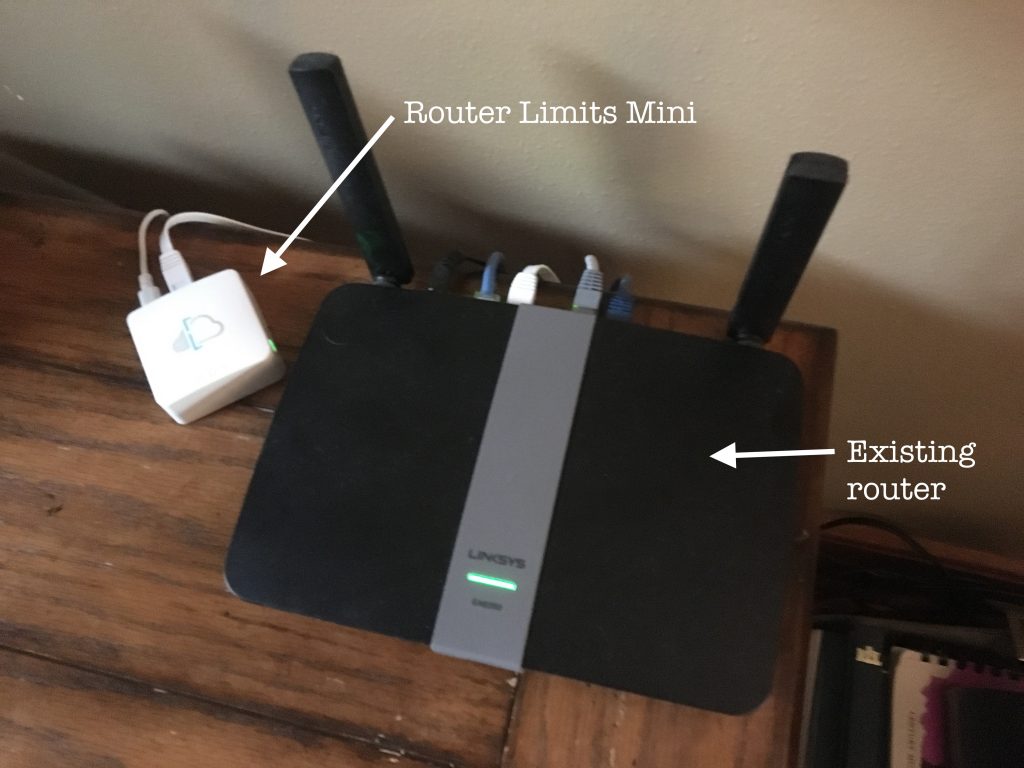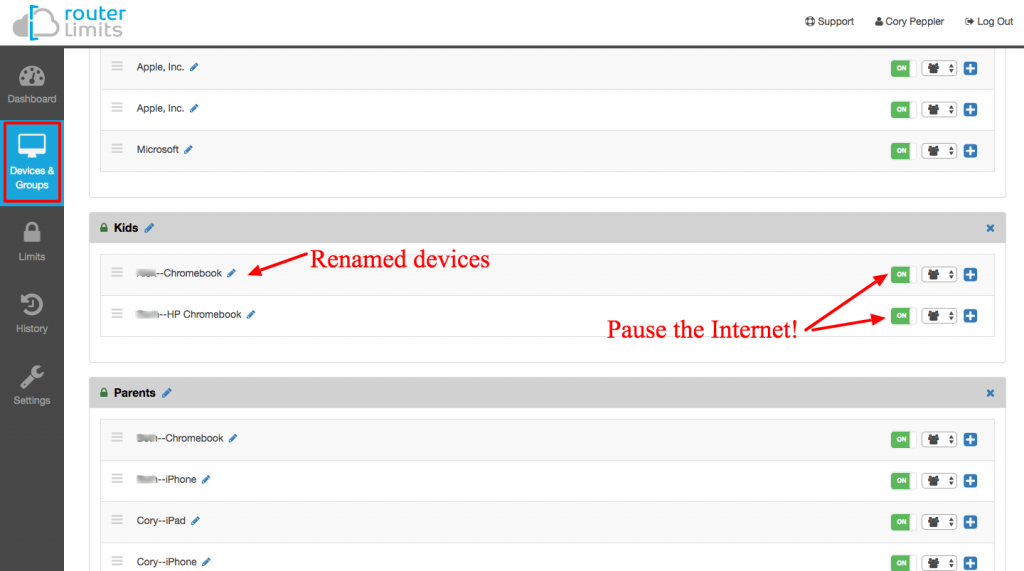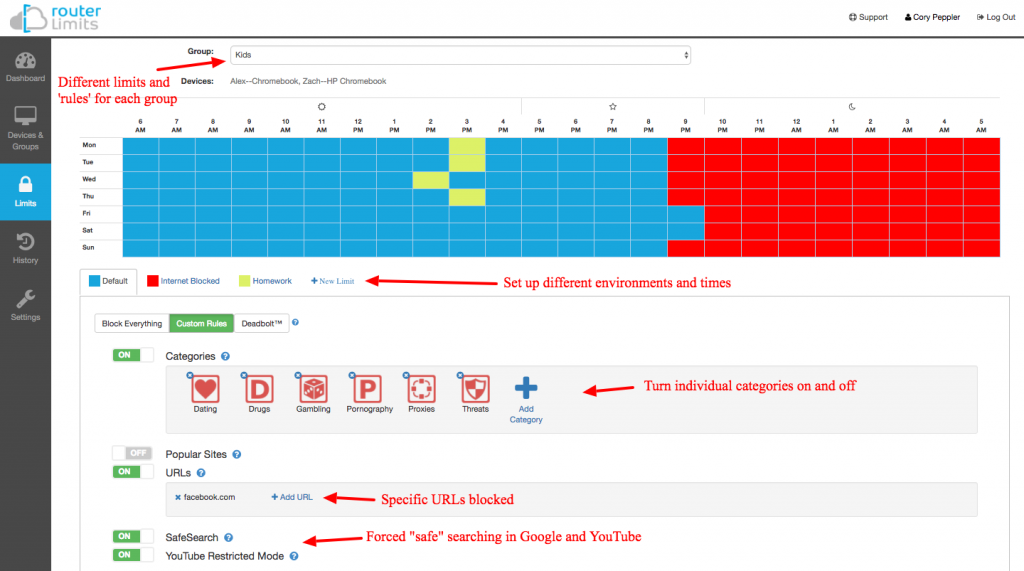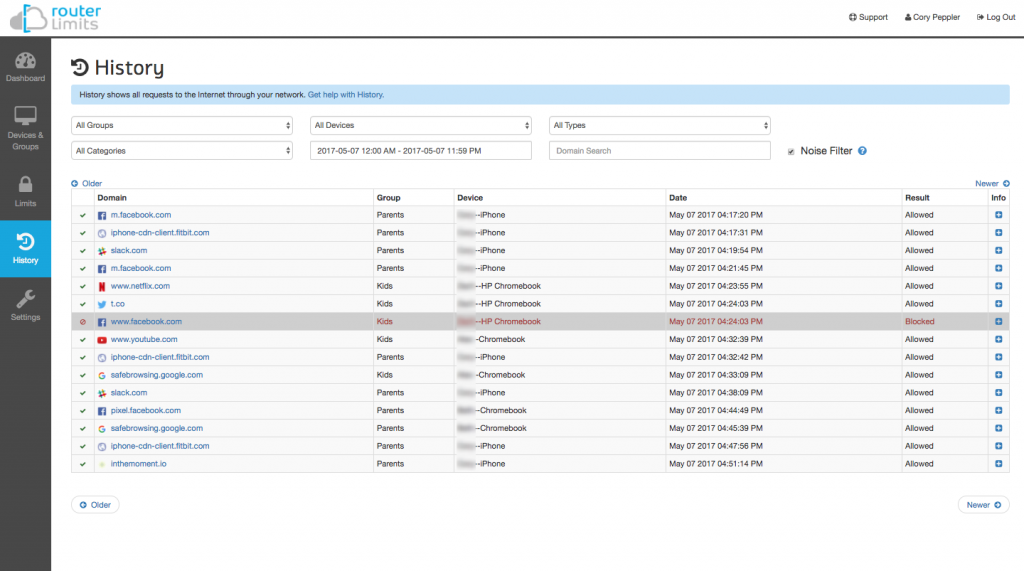What if you didn’t have to install a program or app on every device in your house, yet still be able to keep tabs on what everyone is doing?

That’s the key advantage of devices, like Router Limits, that filter and monitor at the router level. In other words, it keeps track and filters all the traffic that comes through the router itself before it ever gets to the tablet or laptop.
How does it work?
To use Router Limits in your home, you’ll need two elements: a piece of hardware and a monthly service package.
Hardware
Router Limits offers two hardware options. Their RL-150 router replaces your existing router. This plugs into your modem easily, then broadcasts your wifi through your house while also filtering and monitoring that traffic. A number of other compatible routers are also available.
The Mini is a small box that plugs into the back of your existing router. It does the same job, but it’s a nice option if, like me, you just bought a powerful router and don’t feel like replacing it with the RL-150.

Both options are currently listed on the website as $59.
Service
Once you have the hardware plugged in, you choose a service plan. Currently, your two realistic options are the Free and the Premium plans. (They also offer a Small Business plan, which we’ll ignore here.)
The Free plan allows you to filter by category (i.e. porn, gambling, social media, etc.) and by popular sites. History on all devices is kept for three days. You can also just use their Deadbolt setup, which is a blend of the most commonly used filtering settings. Very easy to get this up and running.
The Premium plan is currently $15/month, with the first month free. Premium features allow much more control over devices and the stuff coming in to them. You can group devices (I currently have “Guest”, “Kids”, and “Parents”) or manage individual devices, set shut-off times for each group, block and whitelist specific sites, and “pause” the internet. You can also look 60 days back in the history.
Setting it up
Once you’ve purchased your hardware, log in to routerlimits.com, create your account, and let it find your router or Mini. It will walk you through the account setup, including choosing your plan and taking credit card information.
After this, you can access your Dashboard. If you’ve chosen the Free Plan, your options here are limited. You can basically turn Deadbolt on or off, and you can see your 3-day history.
For Premium users, you can get a snapshot of how many devices are online, and you can navigate through all the various tools in Dashboard. Here’s a quick tour of mine:
Devices and Groups

Here, you can rename all your home’s devices and group them into whatever categories you choose.
Limits

For each group, you can set the filtering settings with both broad categories and specific sites. Here, you can also set up different filtering “environments” for each group, including turning off internet access during certain times.
History

This is a basic listing of all the sites accessed. You can filter it to look at only one device, one group, or a single time period.
What I like
There’s a lot to like about how well Router Limits works. (Note: many of the references below only apply for Premium accounts.)
- It is quite easy to set up, even for those who aren’t very savvy. The trickiest part is renaming the devices. You may have to Google “How do I find the MAC address on [insert device name here]” a few times, or use the help articles on their site. Once this bit of sleuthing is done, though, the rest is pretty straightforward.
- I like how easy it is to group devices, then set different limits and filtering options for each. And moving devices around within groups is a drag-and-drop process, so you can change things up in a couple seconds.
- The ability to set up different environments for different times is powerful. For example, for the “Kids” group (all the boys’ devices), we have the internet turned off after a certain time each night. During homework hours, however, they need some online access. I have the internet on and the usual filter categories on, but I block Netflix, YouTube, and a couple other sites that the kids sometimes use to distract themselves while doing homework.
- Remote access (controlling things from your phone, for example) works the same as the browser version of the Dashboard. It’s easy to modify and check things, even when one of us is away from the house. (I suggest, though, that when you are trying to change time blocks on the Limits screen, go to your browser. Doing this on the phone can be a little maddening, just because of the size. Or maybe I’m just old.)
- At the time of this writing, they are rolling out a smartphone monitoring tool called Everywhere. It’s currently in beta for Android and will be available for iOS soon. Everywhere will allow filtering and monitoring on devices that are outside of the house. Best part, this will be included with all packages. No additional charge. Nice!
What could be better
- While the history panel includes a toggle on/off feature called Noise Filter (keep it turned on!), the listing of visited sites can still be a little unclear. Sometimes it seemed to pick up some “false positives”, listing sites that hadn’t actually been visited. Instead, these were likely ads on the page.
For example, the history for one of my kids said Facebook was accessed periodically during one session, but when I checked his browser history (and I also asked him), he never went to Facebook. This happened a couple times with my own laptop, and with my wife’s Chromebook.
With ad content (and Router Limits does filter a LOT out…just turn off the Noise Filter for a second!) and sites constantly accessing one another, I’m not sure if any monitoring tool can completely discern the difference between these. It does require you to be a little cautious in jumping to conclusions based on what you see on the list.
- With the Mini, you can unplug the device from the router and still surf the web…without filtering. I did get an email after the device had been unplugged for 15 minutes, but a five-minute disconnect did not trigger the same email. Unless you can lock the whole modem/router/Mini cluster behind a lockbox, it is easy enough to bypass with a yank of cable.
To be clear, if you go with the RL-150 or other router option, you cannot bypass it. If you unplug the router to avoid being filtered or monitored, there will be nothing to filter or monitor. Buh-bye, Internet.
Hopefully, this is something that could be tweaked a little to give Mini users more piece of mind. Changing the notification time limit to five seconds or allowing managers to receive a text alert on every disconnect would make the Mini just as attractive as the router option.
Bottom Line
Router Limits is a great option for families with devices, like Chromebooks, that don’t allow any kind of installed program on the device (which is how most filters work.) It is relatively easy to set up, and you can avoid the multiple installs and updates on each device. When new devices come into the house (your kids’ friends?), every guest device is filtered and monitored according to your settings.
Like any filtering tools, this one is not fool-proof. But if you are willing to sift through the history report a little more carefully and go with the router option, instead of the Mini, it’s definitely worth considering adding this tool as a key part of your digital “fence.”
